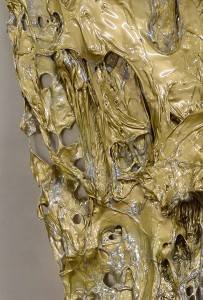meltrans
Shingo Tanaka Solo Exhibition
2016.03.04 (fri.) – 03.27 (sun.)
open on fri., sat., & sun. 12:00-18:00
appointments are available on weekdays
opening reception : 03.04 (fri.) 18:00-20:00
.
Shingo Tanaka has consistently worked FIRE as a theme for his art. As a college student, he pursued the concept “Fire, what the hell is it!,” using many different media to which he applied flames and fire to create sculptures, photographs, and other works.
In recent years, Tanaka has started to employ PVC in his works. Previously, he had frequently used paper and wood, burning the materials completely until they had turned in to ash or charcoal. But, PVC melts and radically transforms when heated. This change is a simple chemical transformation with which everyone is familiar, but Tanaka skillfully repeats the transformation to create beautiful works of art.
Materials that burn with a flame (paper), materials that simply don’t burn (aluminum), materials that change shape (PVC), materials that don’t transform (wire mesh) – Tanaka combines materials such as these in this exhibition’s new group of works and expresses even beyond his previous attempts of phenomena produced without fire and beyond, as if including the connection between man, fire, and the daily objects that we use. Tanaka has come yet another step closer to the nature of “Fire” in the “meltrans” exhibition.
Naomi Rowe | eN arts
.
I make layer upon layer of film or PVC and then burn them over and over again. After the application of heat, the materials shrink, twisting and twirling, as they deform. Then, at the moment a certain critical point is exceeded, the materials start to melt and then begin to liquidify. The PVC is now a liquid, now that the multiple layers of film had been reduced to a single layer, falling drop by drop to the frame/screen/picture.
MELTRANS, the title of this exhibition, is neologism created by combining “melt” and the “trans” of transformation.
The multiple layered PVC is induced to meltdown with exposure to fire. As a petrochemical-based material, it does not leave any ash. As Jacques Derrida, the author of ” Feu la cendre (1987)” observed if people who observe a fire naturally think that “Here is ash, there must have been fire”. I just wonder what kind of memories that the material, which in a way is a symbol of modernity, as it turns first to liquid and then ultimately to a gas, brings us.
Shingo Tanaka
.
.
-WORKS-
-INSTALLATION VIEW-

